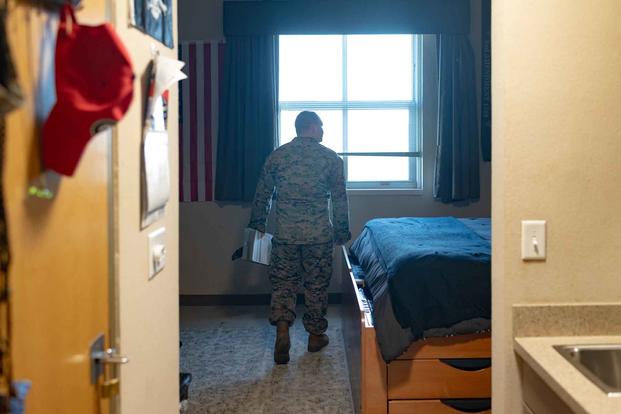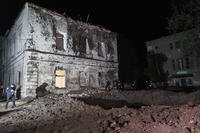The Marine Corps completed its force-wide barracks inspection Friday, marking the end of a month-plus-long effort to assess the state of more than 60,000 rooms across the force, according to a statement from Marine Corps Installations Command, or MCICOM.
The inspection was meant to better understand the state of the barracks, which have recently come under scrutiny across the military. A government watchdog report last year pointed to dismal living conditions in "unaccompanied housing," which is typically occupied by junior enlisted service members and young sergeants.
The Marine Corps inspection "most importantly" looked for health and safety issues, according to MCICOM. It also established a baseline for what is needed in barracks overall -- including for managing mold, moisture, amenities and temperature -- which MCICOM said would help it better direct funds to fix those problems.
"As of three days ago, we finished the entire inspection of all of our barracks all over the globe," Sergeant Major of the Marine Corps Carlos Ruiz told the House Committee on Appropriations on Wednesday. "Now we know we're in a better spot to understand where the rest of the issues are. It's not defendable, and [I'm] not going to, but the commandant has, in fact, invested heavily in the future of barracks.
"Now we will know all over the Marine Corps who's not meeting the mark, and commanders, leadership will be held accountable," he said.
This year's Marine Corps budget plans for a 32% increase in barracks spending -- an ask of $65 million more on top of a multi-hundred-million-dollar portfolio. The service dubbed its efforts Barracks 2030 to help improve living conditions for roughly 17,000 Marines who lived in substandard housing as of last year. It plans to ask for more money, in part, based on the results of this inspection.
Those findings are still being assessed after last Friday's deadline, according to MCICOM, but initial reports were in line with what the Government Accountability Office found last year, it said. A spokesperson for MCICOM would not explain how the initial findings and the GAO report were consistent, but said information would be available after senior leaders are briefed.
The GAO report found that service members lived in squalid conditions, to include mold-infested living quarters with stagnant water, bugs and sometimes squatters.
Military.com spoke to several Marines and a Navy corpsman involved in the inspection, two of whom were part of their unit's inspection teams. The publication also obtained a copy of the inspection checklist from MCICOM, which was used to assess health, safety and environmental matters associated with the barracks.
"We really weren't looking for the cleanliness side of it at all," a Marine, who served as a recorder for the inspection, told Military.com. "We were looking for functionality and livability of the rooms -- if it was actually safe for Marines to be living in that building."
The Marine said their team, of which there were several, coordinated which rooms they would inspect the night before and spent the morning splitting up the barracks for inspection. Those results were then recorded and passed up the chain of command to be compiled by MCICOM. The first week of the inspection was "chaotic," the Marine said, but the teams began rolling through rooms "pretty fast."
The inspection was meant to be carried out by a senior noncommissioned officer or civilian outside of the Marines' chain of command to avoid bias, and service members interviewed by Military.com said the guideline was followed, though some officers were involved as well. According to the checklist, the inspectors looked to see whether locks worked, doors could close, and rooms were free of mold and gas hazards, as well as water damage or even "strong musty odors."
None of the service members Military.com spoke to said that they or their counterparts got in trouble if they failed the inspection. One Marine said that their unit's inspection was "nonchalant."
Some said that the preparations for the inspections were largely routine, and did not include overly vigorous cleaning or painting -- a long-standing pre-inspection habit common in the military and one that a Marine Corps unit reportedly resorted to after squalid facility photos surfaced online earlier this year.
"It wasn't anything that was going to your command to get you yelled at for, or get you in trouble for," a Marine said. "This was going all the way up to try to get allocation, extra money to fix the problems that everybody has."
What some Marines found, experienced
The inspection and its results appeared to vary between units. Some service members said the inspections were rushed or "sudden," while another said they had ample time to complete it. Barracks quality ranged from poor to good to "decently maintained," according to one Marine.
One Marine Military.com spoke to said that they were involved in directly inspecting the barracks. They said that they received a five-minute class on what to look for and were sent to inspect rooms, of which this Marine said they looked at hundreds. They said that the "transient" barracks -- housing for Marines who are coming into and out of an installation, and are not permanently stationed -- were in an "absolutely terrible" state.
Military.com has previously reported on the state of some transient barracks, which see relatively quick turnover if Marines staying there are in training.
"Mold everywhere, roaches, rat infestations, wall lockers torn open and destroyed furniture, missing furniture ... just absolutely disgusting," the Marine said of the transient barracks at their unit. Of the "permanent party" barracks, where Marines live full-time, the inspector said they were mostly in good shape, but some lacked working locks and had missing smoke detectors.
They also said that some rooms were unclean and, because their unit's inspections happened so quickly, the Marines were unprepared for inspectors to come in to look at them. Other service members signaled that their units had plenty of time to conduct the inspection.
"In the future, I would like to actually have more time to do it besides being rushed for inspecting an entire base in a matter of weeks," the Marine said, adding that they conducted multiple inspections of the barracks, including follow-ups to see how maintenance on the problems they identified was progressing.
The Marine said they were able to check in the following week on the status of repairs after conducting re-inspections for certain barracks, but "there was not one barracks room that was fixed yet."
According to criteria provided to Military.com by MCICOM, service members were to be put in temporary housing if certain issues -- such as no running water, broken door locks or unsecured window repairs -- would take longer than 48 hours to fix. If the room was missing or had inoperable smoke detectors or fire sprinklers, the Marine "should be temporarily relocated" until fixed, the memo said.
The inspection noted outdoor and indoor readings of temperature, humidity and dew point, a critical measurement when it comes to mold prevention and ventilation. Mold growth has been something that the Marine Corps -- and other services -- have been dealing with in their decades-old barracks, especially in the South.
One Marine, the recorder, told Military.com that inspectors failed a vast majority of the rooms in their unit due to probable mold or moisture issues in the bathroom area -- a common breeding ground. After it was identified by the inspection teams, civilians would then come in and confirm through testing whether the growths were indeed mold, the Marine said.
If "unidentified biological growth," as the Corps called it in its relocation memo, was discovered, service members were to be moved if the growth could not be assessed within 72 hours. The recorder knew of two Marines who were moved out of their barracks due to mold.
"This isn't exact at all," the Marine said, "but I would say we probably failed 85% to 90% of the rooms that we did just for potential mold and mildew in the showers or in the bathroom, around the toilet, all over."
Efforts to improve barracks
Marine Corps leaders have conceded that fixing the barracks and building new ones will take time, potentially a decade, Marine Corps Commandant Gen. Eric Smith said last year. That said, the Marine Corps put quality of life for Marines and sailors, including barracks improvements, at the top of its unfunded priority list to Congress -- essentially a wish list sent to the Capitol, the service confirmed to Military.com on Tuesday.
It is also conducting a tenant housing survey, through which Marines can submit feedback about their experience in the barracks and government-owned family housing.
Military.com previously reported that the Corps was making several changes to the barracks as it continues to knock down or refurbish old ones. For example, the service said that it plans on replacing enlisted barracks managers, who are responsible for coordinating and fixing housing issues, with professional civilian managers who may be at a unit in a more permanent capacity.
"The inspections also took a holistic approach to inventory all barracks-related issues," Maj. John Parry, a spokesperson for MCICOM, told Military.com on Monday. "This supported setting conditions for a seamless transition for professional civilian managers to hit the ground running with managing, modernizing and improving material in the barracks."
Service members Military.com spoke to generally for this story and previous stories said that civilianizing the barracks manager program is a good idea, with one Marine saying that "it all comes down to who they hire to do the job, so if the person actually cares and takes their job seriously, then I think it'll be a big step forward."
A corpsman told Military.com that their unit's inspection constituted several looks at their room, sometimes more than once in a day. They said that, while the inspection was not a "cure-all" to reenlistment woes or quality-of-life issues that stem from bad barracks, it was a welcome step in the right direction to address them.
"With having to maintain a clean room, there's only so much that is in our control. ... I see it as a necessary overkill," the corpsman said of the inspections. "[It] feels mundane at best when you have more than one inspection in a day. However, I do see the good intentions are there."












